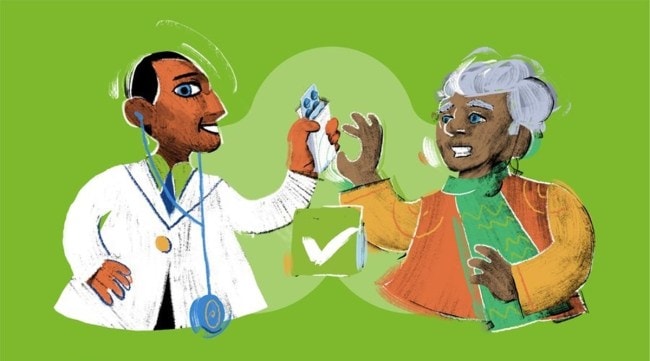Opinion The road to TB-free India: More funds, better utilised
The political leadership is talking about TB elimination and several aid organisations are working towards it. Different actors need to join hands to support the government’s 'inter-sectoral, multi-centric programme approach' for TB elimination and empower community response
 The theme of World TB Day 2023 -- “Yes, we can end TB!” -- conveys a message of hope that getting back on track to turn the tide against the TB epidemic is possible through high-level leadership, increased investments, accelerated action and multi-sector collaboration. (Twitter/@WHO)
The theme of World TB Day 2023 -- “Yes, we can end TB!” -- conveys a message of hope that getting back on track to turn the tide against the TB epidemic is possible through high-level leadership, increased investments, accelerated action and multi-sector collaboration. (Twitter/@WHO) Written by Farhat Mantoo
The year 2023 is critical to push forward the agenda toward ending TB in India. As of 2021, eight countries accounted for more than two-thirds of global TB cases and India contributes to 28 per cent of the global TB burden. As per 2022-23 World Bank data, India spends around 2.1 per cent of its total budget on healthcare (lowest among BRICS countries) and is comparable to Bangladesh (2.5 per cent) and Pakistan (3.4 per cent).
Looking back, our fight against TB started even before independence. In 1929, India joined the International Union Against Tuberculosis. The King George V Thanksgiving Fund for TB control was established to support TB education and prevention, establish clinics, and train health workers. After independence in 1947, the Union government established a TB division under the Directorate General of Health Services with the Ministry of Health to oversee the plan. In 1959, the government, with the help of the WHO, established the National TB Institute in Bengaluru. Subsequently, the National Tuberculosis Control Programme (NTP) was formulated in 1962. The deficiency in the NTP was identified in 1963 and the Revised National TB Control Programme was developed. Fast forward to 2023, India’s National TB Elimination Programme is leading the effort to meet the goal of eliminating TB by 2025, five years ahead of the Sustainable Development Goals.
Today, we are in better times. We have the top political leadership talking about TB and several aid organisations, including Médecins Sans Frontières/Doctors Without Borders (MSF), working in this space. We see this as an opportune moment to exchange lessons learned from implementation programmes. Different actors need to join hands to support the government’s “inter-sectoral, multi-centric programme approach” for TB elimination and empower community response at the grass roots level.
The theme of World TB Day 2023 — “Yes, we can end TB!” — conveys a message of hope that getting back on track to turn the tide against the TB epidemic is possible through high-level leadership, increased investments, faster uptake of new WHO recommendations and adoption of innovations, accelerated action and multi-sector collaboration.
In a scenario where there is political will to eliminate TB, the key to making progress is the investment of resources in a strategic manner and leverage from innovation and newer treatment regimens. We need a variety of actors to prioritise funding to keep pace and in some cases accelerate progress, as this is vital to inching toward the ambitious target that we have set ourselves as a country. The challenge in India continues to be the pace of programme implementation, which witnessed a slowdown with Covid-19, while also incorporating new components. This requires further policy development, planning, and additional financing.
Globally, some developments indicate a gradual shift from international to domestic funding for TB. While it is a welcome direction, we should continue investing to make sure the pace and focus are not lost. MSF’s experience speaks of pockets of populations in countries like India that are akin to low-income countries in terms of resource allocation while the country itself has made progress on many other indicators. For instance, the most widely used test for diagnosing active TB in low- and middle-income countries relies on examining a patient’s phlegm under a microscope.
However, India’s national programme has upscaled genotypic testing – that is, CB-NAAT (Cartridge Based Nucleic Acid Amplification Test)/Truenat to subdistrict levels (CB-NAAT and Truenat are chip-based, point-of-care, rapid molecular tests for diagnosis of infectious diseases). But in order to screen complicated drug-resistant profiles or drug-resistant forms of TB, we need to introduce Xpert XDR tests. (Xpert XDR is a rapid test for detecting tuberculosis and drug resistance in one test, suitable for laboratories that do not require advanced skills and infrastructure.)
As countries consider shifting their current treatment strategy to shorten all-oral regimens, and with the price of diagnosis and treatment coming down, it is critical that TB programmes consider how best to repurpose these savings. Investment in expanding TB case detection efforts or improving TB prevention efforts in our country could move us closer to a world without TB. Investing the savings in strategic areas like diagnostics and access that have been barriers in the past is critical for reshaping the national TB strategy.
The Joint Monitoring Mission Report 2019 by the Ministry of Health mentions that while there has been some progress in implementing the programme’s strategies and activities, the slow release of funds has had a significant impact on the programme’s effectiveness. The low fund utilisation has resulted in a lack of resources for critical TB control interventions, such as early detection, diagnosis, and treatment, which are essential to achieving the programme’s goals. Frequent evaluation on this front will help in addressing the challenge of underutilisation.
While adopting newer treatment regimens and embracing innovation, we also have to prioritise sustainability. This can be achieved by strategic investing, putting money where it is needed most, and adequate resourcing of TB initiatives. Together we can make it happen.
The author is Executive Director at Médecins Sans Frontières (MSF)/Doctors Without Borders, South Asia



